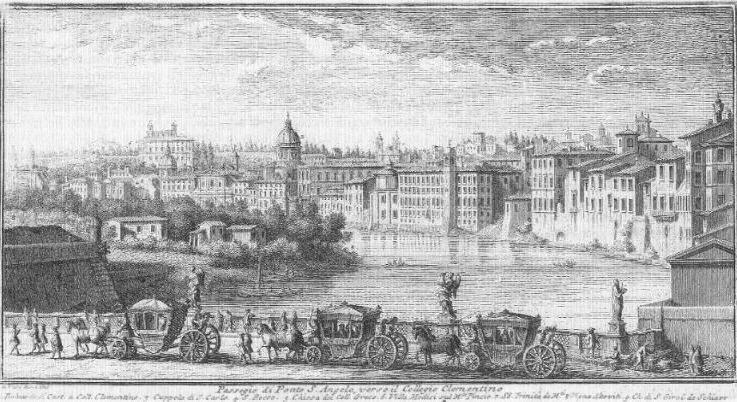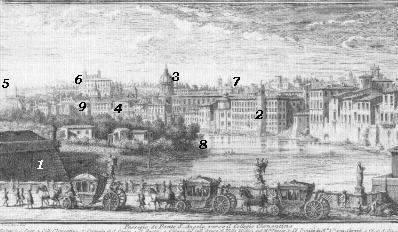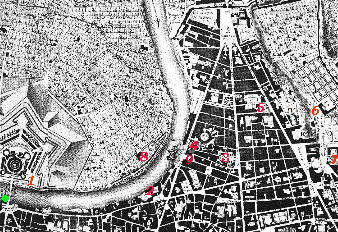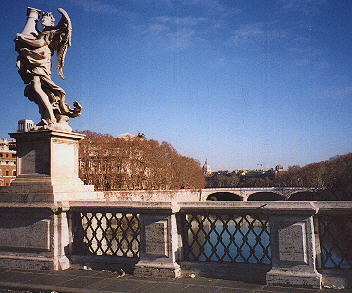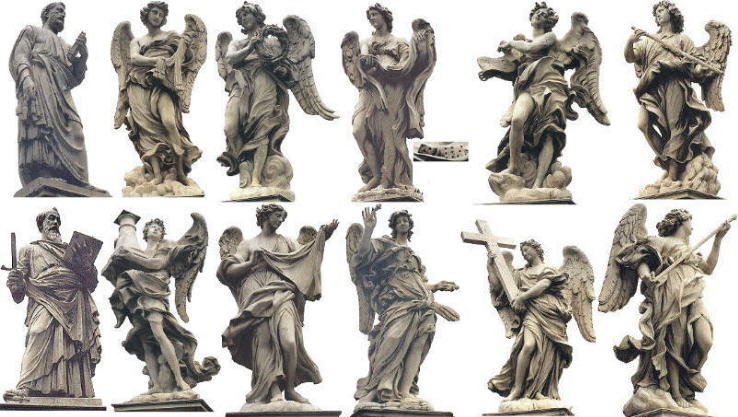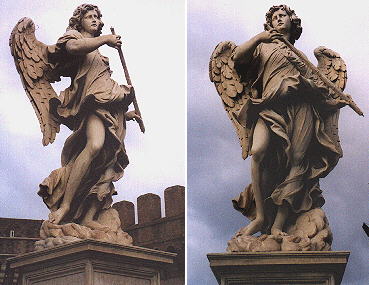  Passeggio di Ponte S. Angelo (Book 5) (Map C2) (View C4) (Day 8) (Rione Borgo) In this page:
This plate shows a very interesting view of the houses and palaces
directly overlooking the river and some Roman landmarks in the background. The view is taken from the green dot in the small 1748 map here below.
In the description below the plate Vasi made reference to: 1) Bastion of Castel Sant'Angelo;
2) Collegio Clementino; 3) Dome of S. Carlo al Corso; 4) S. Rocco; 5) S. Attanasio dei Greci;
6) Villa Medici; 7) SS. Trinità dei Monti; 8) Vigna Altoviti; 9) S. Girolamo agli Schiavoni.
All but 8) are shown in detail in other pages.
A curtain of trees separates the river from the city. Collegio Clementino has been replaced by a modern building: only the dome of S. Carlo al Corso assures us that we are viewing what Vasi saw. Passeggio:
then let's walk and cross the river to go to Castel
S. Angelo. Two saints and ten angels holding elements of the Passion
will be with us. Left side of the bridge (first row in the picture here below): St Peter (school of Lorenzetto), the
scourge (by Lazzaro Morelli), the crown of thorns (by Paolo Naldini from an original by Gian Lorenzo Bernini now in
S. Andrea delle Fratte), the dice (by Paolo Naldini), the derogatory inscription (I.N.R.I.) (by Gian Lorenzo Bernini),
the offer
of vinegar (by Antonio Giorgetti); right side of the bridge (second row): St Paul (school of Paolo Taccone), the throne (by Antonio Raggi),
the poor vestment (by Cosimo Fancelli), the nails (by Girolamo Lucenti), the cross (by Ercole Ferrata), the lance (by Domenico Guidi).
In the background the light balustrade of Ponte degli Angeli by Gian
Lorenzo Bernini. The statues of St Peter and St Paul were erected by Clemens
VII. The statues of the angels were commissioned to Bernini by Alexander
VII. They were executed by Bernini's pupils from his designs and put in
place in 1670. Bernini used to prepare full scale models made in clay to visualize
the final effect of the statue; some of these models can be seen in the Vatican Museums (near the picture gallery). Although statues
are tridimensional objects they usually have a preferred point of view. Most of them were put in niches and thus are best viewed frontally. The Perseus by Benvenuto Cellini, holding the head
of Medusa, gains from a lateral view. Bernini's statues often were designed for being viewed from different angles. His early
works for Cardinal Borghese (Apollo and Daphne, Rape of Proserpine) were immediately recognized as masterpieces because they were equally viewable from different angles. Bernini gave instructions
on the exact positioning of the statues in the room taking into account the proximity of windows. Apollo and Daphne was first to be seen from the back to discover only in a second moment that the young woman was turning into a tree. For the angels of the bridge,
Bernini devised three points of view, bearing in mind that people would be crossing the bridge in both directions. So in addition to the frontal view the statues can be seen also at a 45 degree angle.
The wings of the angels are opened in a manner to be seen frontally at such lateral views
(for more baroque angels click here). Here below two other views of the last angel in the first row.
Here below the inscriptions under each statue:
P. S.: The decoration with statues of the bridge inspired the Jesuits of Prague who promoted the decoration with statues of saints of the main bridge of Prague. Excerpts from Giuseppe Vasi 1761 Itinerary related to this page:
Next plate in Book 5: Ponte e Mole Adriana Next step in Day 8 itinerary: Ponte e Mole Adriana
Go
to |
All images © 1999 - 2003 by Roberto Piperno. Write to romapip@quipo.it
